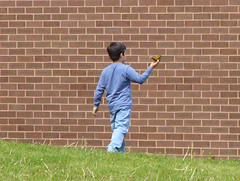My C.A.P. squadron had a major activity Monday - we went to the Pocono Elementary Center in Tannersville, PA to teach their students about aviation. We have done this twice before, in the last three years, but with much smaller groups of students. Aerospace education is one of the functions of the Civil Air Patrol, along with our search-and-rescue mission and our cadet program.
The principal, Catherine Sweeney, allowed us to fill four long periods through the school day, for all 950 (!) of the students, so we had our work cut out for us. We marshalled all of our cadets, and all of our best classroom materials and activities, and spent a long time working out the schedule and practicing the lessons. Many of our younger cadets were getting their first experience teaching classes, and in front of some big groups! This was a maximum effort; we had less than twenty of our kids and seven CAP officers to take on this large student body.
We also brought in some help, as we have before, from the local aviation community. Carl House and Dave Zahorsky from the Waymart Wings model airplane club set up a model airstrip and flight line, and brought an impressive little fleet of airplanes, gliders and helicopters. John Vogler, a retired gentleman from the Stroudsburg chapter of the EAA, graciously agreed to trailer his full-scale homebuilt aircraft to the school and give a presentation. He put in a hard day's work in the sun behind the school, describing his partly-completed Pietenpol Aircamper - a beautiful design from the 1930s, crafted mostly of wood.
In previous years, we had flown in helicopters; and also done candy parachute drops, to start the day off on a high note. The school staff was concerned about the liability of landing the helos, though, so I opened the day by flying over the school in the C.A.P. Cessna. The airport is only seven miles from the school, so I took off and circled until the appointed time; at 9:29, I dove on the school from the north and let the airspeed build up. At 9:30 exactly, I skimmed over the school, where the first classes were gathering outside. I did a low pass at high speed, over 150 m.p.h., and pulled up into a maximum-performance turn to the left. Not that amazing in airshow terms, but a decent little demonstration, and I climbed to orbit the school and take a few snapshots.
After landing back at the airport I drove over to the school, where our cadets were already at work teaching a variety of subjects. The most ambitious was the rocketry presentation behind the school, set up by our very advanced 13-year old Frankie Arnold. Cadet Arnold brought his model rocket launch pads, and made some impressive visual aids out of found materials; he taught four long classes, and at the conclusion of each called for volunteers from the Pocono kids to help him launch a few rockets. The kids were awestruck, of course, and today in our first batch of thank-you cards many of them mentioned his class as their favorite.
Three of our young lady cadets - Annalea Littleton, Julia Rasely and Grace Tighe - took on the task of preparing lessons for the youngest classes, the kindergarten and first grades. They adapted some lesson plans we got from NASA, which has many excellent resources for teachers. Using streamers, balloons and straws, they demonstrated that air is a substance and has pressure, and can do work. They bubbled with energy and did a great job of connecting with the kids, as good as any college student teachers.
Juan Montealegre, one of the youngest but most enthusiastic of our cadets, headed the class on parachutes; he and his comrades worked hard in the preceding days making dozens of small clothespin parachutes. They filled the second half of their allotted time with "AlkaFuji" rockets, made from film canisters and powered by Alka-Seltzer tablets. (They pop off the desk, surprisingly high, in a lovely frothy mess!)
Some of the older cadets gave presentations on the Civil Air Patrol and our search-and-rescue missions, demonstrated radio direction-finding, and our field gear. I took the last segment of the day to teach the fifth and sixth grades about the basic physics of flying, the "four forces", and concluded with a Q&A period. Afterwards, I had a semicircle of fifth and sixth graders around me, asking about our cadet program and how they can get involved.
All in all, the day went off as seamlessly as we could have hoped. The weather was beautiful, the school kids had a ball, and the faculty was very appreciative. I couldn't be prouder of the officers and cadets in my unit; they all worked hard to make this happen. I've uploaded some pictures of the day in my Flickr album here.
